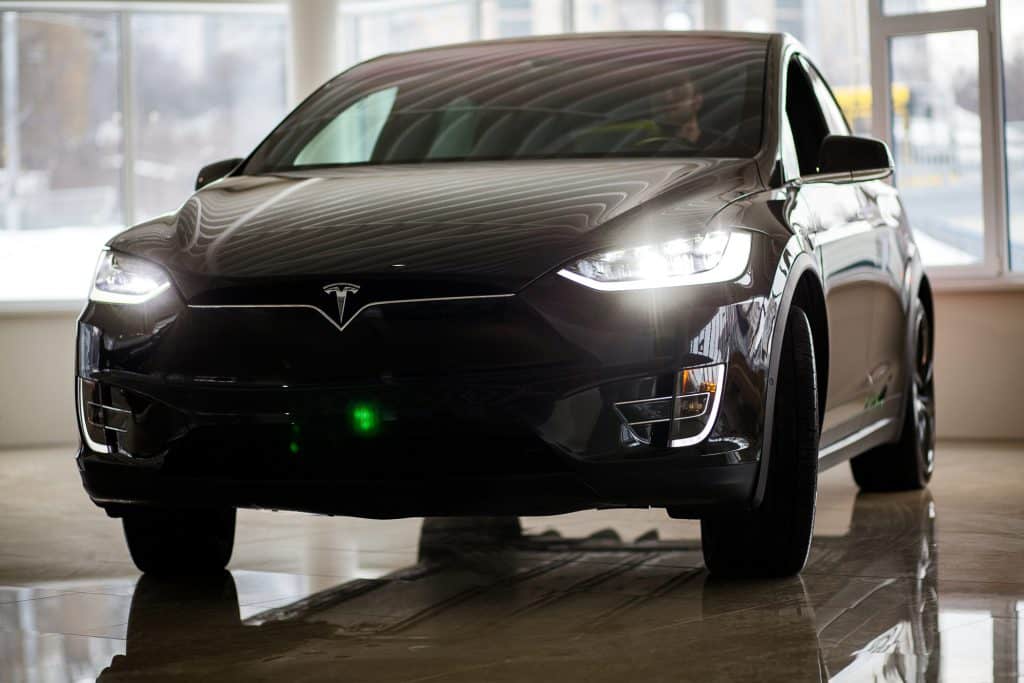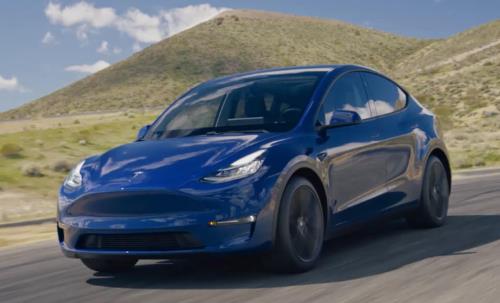Have you ever seen a Tesla rolling down the road and thought there was something off about it? Did it feel like there was something missing? Depending on where you were at the time, there’s a good chance that the Tesla you saw was driving along without any license displayed at the front of the car. That’s the thing that you felt was missing.
Why Don’t New Teslas Come with Front License Plates?
If you’ve bought a new Tesla recently, you’ll know that while the license plate is absent from the front, Tesla does provide you with a front license plate holder.
This adheres to the front bumper via the included adhesive tape, which is fairly strong and durable. However some people prefer third party drill mounts (which requires some additional drilling in the front nose cone to install), instead of relying on adhesive.
Perhaps as part of the overall aesthetic, or perhaps to save on production steps in the face of currently varied and changing laws, Tesla opts not to pre-drill that front space to make room for a license plate.
Later, Tesla dealerships are supposed to inform buyers that they can have one installed, but it seems that an increasing number of drivers are not doing so.
Is it Legal to Drive Without Front License Plates?

As it happens, there has been an ongoing battle between car owners and police and other interested parties on this topic. In July 2020, Ohio became one of what is now 20 states in the US that do not deem front license plates necessary.
Note: Tesla aren’t the only car maker who deliver some cars without front license plates. We’re focussing on Tesla in this article, but it’s common to see cars without front plates in America.
The argument from car owners was that front license plates damage the bumper, restrict the flow of air into the grille, and even impact the overall aerodynamism of the vehicle. Others also pointed out that removing the need for a front license plate cuts down production need by half, thus saving on resource and labor costs.
There were other arguments used by lawmakers in Ohio, too, such as missing front plates being illegal then leading to racial profiling. A missing front license plate was the whole reason for pulling over Sam DuBose in 2015, an incident that eventually turned into a fatal shooting. Making them legal would ensure that police had to have better reasons for pulling people over.
In the wider scope, another key reason to not include front plates is safety. There are those that have pointed out that front license plates get in the way of adaptive cruise control, lane-keep assist, automatic braking and other ADAS and safety features. These features depend on carefully placed cameras and sensors, which can be interfered with by front license plates.
States that don’t require a front license plate include Alabama, Arizona, Arkansas, Delaware, Florida, Georgia, Indiana, Kansas, Kentucky, Louisiana, Michigan, Mississippi, New Mexico, North Carolina, Ohio, Oklahoma, Pennsylvania, South Carolina, Tennessee and West Virginia.
Police disagreed with this assessment, citing the need for front license plates for the easier identification of approaching vehicles. Other authorities objected because their existing toll systems relied on scans of the front license plate to take effect, which therefore impacts local revenues.
Countering Police Arguments
On the surface, it seems reasonable for Police to claim that being able to identify a vehicle from two directions is better than just one. For cars dating back to 1980, it was also undeniably true that there were precious few (if any) other ways to identify a vehicle on the road short of just stopping the driver anyway and asking to see their license and registration.
As we all know, though, automotive technology has come a long way in the past few decades. With all the digital systems and signals that cars are emitting to scan the road and receive information from the worldwide web, how inconceivable could it be for police officers to able to simply tap into some frequency and pull up information on cars in that way?
Alternatively, there’s scope for digital plates that police could scan. Such plates are only currently legal in Arizona, California and Michigan, but where some have pioneered and led the way, others will inevitably follow. The 20 states allowing no front plates didn’t all jump on the bandwagon at once.
Can You Drive a Tesla with No Front Plates in California?

California is known for its strict levels of regulation when it comes to many areas, and automotive is one of them. They have the most stringent emissions standards, and a slew of other laws governing your cars. Until 2019, it was law in California that no front plate on a car was only allowed on new cars for a grace period of up to 6 months, presumably while you navigated local bureaucracy to acquire plates from the DMV.
This later became known as the “Steve Jobs loophole,” because those with the wealth and inclination — as Jobs did — could get around having plates by simply leasing a new car every six months to avoid having plates. What was the result? Jobs could cruise around California, never paying tolls or bridge fees because there was no plate to track and charge. This was finally closed down in 2019, requiring all new cars to have at least temporary plates that are a stopgap until the real plates are confirmed.
To be more precise, California’s main license plate law is called CVC 5200, and the relevant section clearly states that:
when two license plates are issued by the department for use upon a vehicle, they shall be attached…one in the front and the other in the rear.
California CVC 5200 regulations.
The law does say, however, that one plate is acceptable if — for whatever reason — there is only one license plate that has been issued for that vehicle.
A Tesla may be a fancy, high-end, no-emission vehicle, but it’s still a standard passenger car and is thus issued with two license plates. California shows no signs of joining the 20 states that have already ditched them. Nor does California’s typically opposite fellow state of Texas, whose requirement for front license plates mirrors California’s. Failure to comply with this law can result in a ticket of up to $196.
Conclusion: Don’t Break the Law, but You Might Only Get a Fix-it Order
In conclusion, it seems that the answer to our core question on Teslas has many parts, but all are connected to the same main answer — people don’t want to stick adhesive onto the front nose cone of their beloved (and exceedingly expensive) Tesla cars. Others are concerned about the other things we’ve mentioned, especially interfering with Tesla’s many ADAS and even self-driving features.
Furthermore, a part of the US Tesla ownership doesn’t have front license plates because their states permit them not to have them. These residents of the 20 states mentioned above don’t have to worry about being pulled over by police for not having a front plate, nor do they have to contemplate sticking adhesive tape all over the pristine Tesla body’s surface.
Those who live in states like California and Texas, and the other 28 states who insist on front plates, will do one of two things. They will either follow the demands of the law, bite the exceedingly bitter bullet and have the Tesla dealership or other qualified mechanic attach the license plate holders on the front, or they will take their chances by not hanging their front license plate and just hoping that the police take no notice.
A lot of driver testimony suggests that the worst one could expect is a small fine and a “fix-it ticket” where your main punishment is that you have to go have something fixed or done. This is akin to the police discovering that you have a broken taillight, for example.
In our view, however, it’s never a good idea to break the law. If your state requires it, then affix those plates and continue to be a lawful road user. If it really is too much, then consider a different EV onto which you’d be willing to affix those plates.

I live in CA. When I bought my used car, there was only a rear license plate. How do I know if only one plate was issued for the car, and it’s legal to drive that way, or if a previous owner perhaps removed the front plate, and I’m in violation? Would a 2010 Toyota Scion have two plates?
Hello,
So firstly I need to say that “I am not a lawyer”! My understanding from looking at various images of the 2010 Toyota Scion is that it does NOT have a front plate (just Google “2010 Toyota Scion” and go to “Images”).
So you should be fine… but again, I’m not a lawyer (etc). You could always contact the DMV and see if they can confirm either way?
Yes. All passenger cars are issued two plates in CA. A Toyota Scion would not be an exception.
It doesn’t matter what the previous owner may have done. You are in violation to drive the car in CA. Contact the DMV and get a new plate. There is no charge (last time I checked).
I can’t figure out why Teslas are singled out for this. Many, many thousands of non-Tesla cars out there without front plates.
And no…. mounting the front plate does not require drilling. The mounts come with double-sided tape. The same that attaches various moldings and emblems.
Apologies, you’re right to point out that they don’t require drilling. That’s been updated now.
In terms of why this article focusses on Tesla, we received various questions specifically about Tesla – so did the article centred around them. I’ve included a note that this applies to many non-Tesla cars too, though.
Wonder why Tesla just doesn’t just provide the four mounting fasteners for the front as they do for the rear–as is done for mos other cars. You cannot convince me its due to cost…
Probably because 9 out of 10 Teslas don’t have a front tag.
states that issue 2 license plates per vehicle can use the second plate for another vehicle if you allow 1 plate per vehicle
I was at a supercharger station recently where 6 out of 10 Teslas (all California plates) did NOT have a front plate. I applied my adhesive front plate in less than 5 minutes and it has been on the car for over 5 years, so I am not sure why there are so many offenders.
I do an informal poll while I’m driving. It’s predominantly Teslas driving around without license plates. I see a lot of Mercedes without them as well. I thin it’s mostly atragante and a lack of tickets being issued. InTe as it’s a $200 fee.